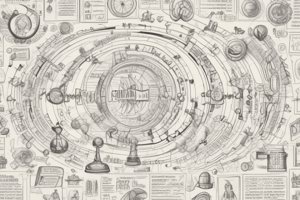Podcast
Questions and Answers
What is classified as conceptual resources in the context provided?
What is classified as conceptual resources in the context provided?
- The physical smartphone itself
- Smartphones
- Pictures and videos on a mobile phone (correct)
- Files saved on the smartphone (correct)
How is information defined in the provided context?
How is information defined in the provided context?
- Random thoughts and opinions
- Raw data without additional context
- Facts that have been organized and processed (correct)
- Only as validated truths
What characteristic of information allows it to be expanded without loss of integrity?
What characteristic of information allows it to be expanded without loss of integrity?
- Accessibility
- Expandability (correct)
- Compressibility
- Transportability
Which of the following examples illustrates compressibility of information?
Which of the following examples illustrates compressibility of information?
What does the transportability of information refer to?
What does the transportability of information refer to?
Why is information considered sharable?
Why is information considered sharable?
Which characteristic of information makes it easy to spread rapidly, both true and false?
Which characteristic of information makes it easy to spread rapidly, both true and false?
In the context, what is emphasized as a particular virtue of information?
In the context, what is emphasized as a particular virtue of information?
What is a characteristic of valuable information?
What is a characteristic of valuable information?
Which type of source is generally considered more reliable for research?
Which type of source is generally considered more reliable for research?
What does 'garbage-in-garbage-out' refer to?
What does 'garbage-in-garbage-out' refer to?
What aspect of information does 'complete' refer to?
What aspect of information does 'complete' refer to?
Why might informal information still be deemed useful?
Why might informal information still be deemed useful?
Which type of information is less likely to be carefully prepared and verified?
Which type of information is less likely to be carefully prepared and verified?
What is the main challenge regarding information from wikis, particularly Wikipedia?
What is the main challenge regarding information from wikis, particularly Wikipedia?
Which characteristic distinguishes formal information from informal information?
Which characteristic distinguishes formal information from informal information?
What could happen if information regarding a patient's allergies is missing?
What could happen if information regarding a patient's allergies is missing?
Which factor most influences the reliability of information?
Which factor most influences the reliability of information?
What characterizes flexible information?
What characterizes flexible information?
Why is relevant information crucial for decision-makers?
Why is relevant information crucial for decision-makers?
What does it mean for information to be timely?
What does it mean for information to be timely?
Which of the following best defines verifiable information?
Which of the following best defines verifiable information?
What is the main consideration regarding the economical production of information?
What is the main consideration regarding the economical production of information?
How should information be presented to avoid confusion?
How should information be presented to avoid confusion?
What is a key feature of information sharing in emails and SMS?
What is a key feature of information sharing in emails and SMS?
What is an 'experience good' in economics?
What is an 'experience good' in economics?
What challenge do organizations face in the information economy?
What challenge do organizations face in the information economy?
What strategy allows customers to get a preview of a product or service?
What strategy allows customers to get a preview of a product or service?
What is an example of a browsing preview strategy mentioned?
What is an example of a browsing preview strategy mentioned?
What technology do mobile payment apps like Samsung Pay and Apple Pay utilize for transactions?
What technology do mobile payment apps like Samsung Pay and Apple Pay utilize for transactions?
Which method is commonly used for biometric authentication in mobile payment systems?
Which method is commonly used for biometric authentication in mobile payment systems?
In evaluating information, what is necessary for individuals?
In evaluating information, what is necessary for individuals?
What type of marketing strategy helps consumers learn about new experience goods?
What type of marketing strategy helps consumers learn about new experience goods?
Which characteristic of information implies that additional copies can be produced at little to no cost?
Which characteristic of information implies that additional copies can be produced at little to no cost?
Which of the following statements about non-rivalrous information is true?
Which of the following statements about non-rivalrous information is true?
What implication does social media sharing have on privacy?
What implication does social media sharing have on privacy?
What is the primary value of information for businesses?
What is the primary value of information for businesses?
What does the term 'non-exclusive' mean in the context of information goods?
What does the term 'non-exclusive' mean in the context of information goods?
In the context of information goods, what describes their cost structure?
In the context of information goods, what describes their cost structure?
How is information considered valuable in today's business environment?
How is information considered valuable in today's business environment?
What impact did Apple's introduction of the iPhone 7 have on pre-order sales compared to the iPhone 6?
What impact did Apple's introduction of the iPhone 7 have on pre-order sales compared to the iPhone 6?
What role does the reputation of directors and cast play in the success of a movie?
What role does the reputation of directors and cast play in the success of a movie?
Based on Cisco's study, what was the expected global internet traffic by 2019?
Based on Cisco's study, what was the expected global internet traffic by 2019?
How much data is equivalent to 1 zettabyte in terabytes?
How much data is equivalent to 1 zettabyte in terabytes?
What has enhanced the speed and ease of information duplication and transmission?
What has enhanced the speed and ease of information duplication and transmission?
What communication methods have evolved with the advent of smartphones?
What communication methods have evolved with the advent of smartphones?
What is one way that libraries have adapted to the growth of digital information?
What is one way that libraries have adapted to the growth of digital information?
Which of the following is a consequence of information overload due to increased digital communication?
Which of the following is a consequence of information overload due to increased digital communication?
Flashcards
Conceptual Resources
Conceptual Resources
Data, information, or knowledge stored in a computer system.
Physical Resources
Physical Resources
The physical objects, like smartphones, that hold or manage conceptual resources.
Information
Information
Facts, processed data about something or someone.
Expandable Information
Expandable Information
Signup and view all the flashcards
Compressible Information
Compressible Information
Signup and view all the flashcards
Transportable Information
Transportable Information
Signup and view all the flashcards
Sharable Information
Sharable Information
Signup and view all the flashcards
Processed Data
Processed Data
Signup and view all the flashcards
Accurate Information
Accurate Information
Signup and view all the flashcards
Inaccurate Information
Inaccurate Information
Signup and view all the flashcards
Formal Information
Formal Information
Signup and view all the flashcards
Informal Information
Informal Information
Signup and view all the flashcards
Complete Information
Complete Information
Signup and view all the flashcards
Valuable Information
Valuable Information
Signup and view all the flashcards
Wikipedia.org
Wikipedia.org
Signup and view all the flashcards
Reliable Information Source
Reliable Information Source
Signup and view all the flashcards
Economical Information
Economical Information
Signup and view all the flashcards
Reliable Information
Reliable Information
Signup and view all the flashcards
Flexible Information
Flexible Information
Signup and view all the flashcards
Relevant Information
Relevant Information
Signup and view all the flashcards
Simple Information
Simple Information
Signup and view all the flashcards
Timely Information
Timely Information
Signup and view all the flashcards
Verifiable Information
Verifiable Information
Signup and view all the flashcards
Accessible Information
Accessible Information
Signup and view all the flashcards
Forwarding information
Forwarding information
Signup and view all the flashcards
Information Economics
Information Economics
Signup and view all the flashcards
Experience Good
Experience Good
Signup and view all the flashcards
Differential Pricing
Differential Pricing
Signup and view all the flashcards
Browsing Previews
Browsing Previews
Signup and view all the flashcards
Movie Trailers
Movie Trailers
Signup and view all the flashcards
Transparency
Transparency
Signup and view all the flashcards
Information Cost
Information Cost
Signup and view all the flashcards
Mobile Pay
Mobile Pay
Signup and view all the flashcards
NFC Technology
NFC Technology
Signup and view all the flashcards
Biometric Authentication
Biometric Authentication
Signup and view all the flashcards
Zero Marginal Cost
Zero Marginal Cost
Signup and view all the flashcards
Non-rivalrous
Non-rivalrous
Signup and view all the flashcards
Non-exclusive
Non-exclusive
Signup and view all the flashcards
Value of Information (Business)
Value of Information (Business)
Signup and view all the flashcards
Information characteristics (4)
Information characteristics (4)
Signup and view all the flashcards
Brand Recognition
Brand Recognition
Signup and view all the flashcards
Reputation Building
Reputation Building
Signup and view all the flashcards
Information Overload
Information Overload
Signup and view all the flashcards
Easy Information Duplication
Easy Information Duplication
Signup and view all the flashcards
Increased Communication Methods
Increased Communication Methods
Signup and view all the flashcards
Growth of Historical Information
Growth of Historical Information
Signup and view all the flashcards
Global Internet Traffic
Global Internet Traffic
Signup and view all the flashcards
Zettabyte
Zettabyte
Signup and view all the flashcards
Study Notes
Introduction to Resources
- Organizations view company assets (buildings, equipment, manpower) as resources.
- Resources are all available means for increasing company production or profit.
- Resources include land, labor, capital, and raw materials.
- Without resources, organizations cannot exist.
- Physical resources are tangible (e.g., money, forklifts, teachers).
- Physical resources are acquired and assembled for use as needed, often converting raw materials into refined forms.
- Managers maximize resource usage by allocating space, and planning for replacement/repair before resources become inefficient or obsolete.
Conceptual Resources
- Conceptual resources are non-tangible and valuable for what they represent (e.g., money, skills, experience).
- Employees' skills, knowledge, and experience set them apart, making them valuable.
- Conceptual resources are used to manage physical resources, and vice versa (e.g., computer usage in organization).
- Digital content stored on computers becomes irreplaceable resources.
- Security measures for computer units (e.g., firewalls, anti-virus) are used to protect valuable data (conceptual resources).
- Information (data, facts) is considered a conceptual resource. Relevant verifiable truths with validated meaning and value.
- Data, when organized, become information.
Information as a Resource
- Information is defined as facts about something or someone.
- Facts need to be validated and identified as relevant truths
- Information has additional value beyond the value of the facts themselves.
Valuable Information
- Accurate information is error-free.
- Formal information is authoritative, well prepared, and reliable (e.g., academic websites).
- Informal information is more casual and less reliable (e.g., blogs or forums).
- Complete information contains all essential facts.
- Economic information has a balance of value over production cost.
- Reliable information depends on valid data and sources.
- Flexible information can suit various situations.
- Relevant information is important to a decision-maker.
- Simple information is easy to understand.
- Timely information is available when needed.
- Verifiable information is correct and authentic.
- Accessible information is easily obtained by authorized users.
- Secure information is protected from unauthorized access.
Information Characteristics
- Information can be expanded without losing integrity.
- Information is easily transportable (via email, social media, etc.)
- Information can be diffused (spread) easily.
- Information can be shared easily.
- Information is potentially valuable in different industries (e.g., medicine, finance).
Growth of Information
- Digital copies have replaced many physical archives.
- Online resources (e.g., e-books, e-journals) are increasingly common.
- Mobile devices and communication methods have simplified access to and transmission of information.
- The speed and volume of digital information are rapidly increasing.
- The use of social media platforms and mobile applications have increased the speed of information transmission.
- The information overload problem is a consequence of the rapid expansion of digitized information sources.
Studying That Suits You
Use AI to generate personalized quizzes and flashcards to suit your learning preferences.
Related Documents
Description
This quiz explores the various types of resources that organizations rely on, including both tangible and intangible assets. Learn how managers maximize resource utilization and ensure operational efficiency. Test your understanding of physical and conceptual resources and their importance in business management.




